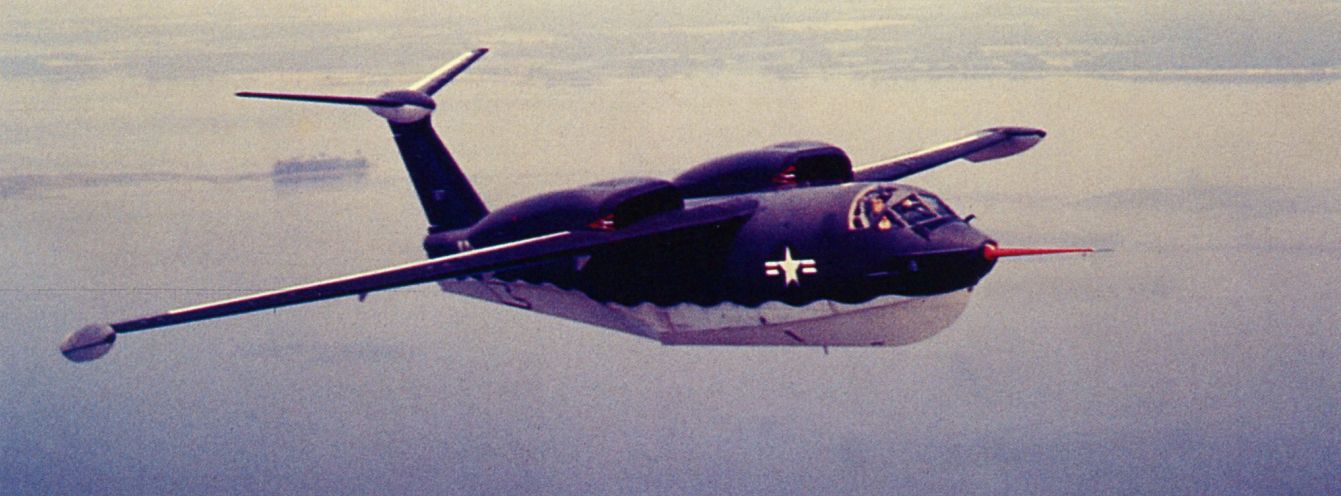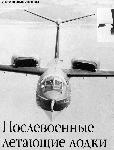
Martin P6M SeaMaster
В рамках тендера, объявленного ВМС США на новую многоцелевую летающую лодку, обладающую высокими летно-техническими характеристиками, компания "Martin" предложила свою новейшую разработку - Model 275. Самолет имел цельнометаллический корпус с высоким относительным удлинением, свободнонесущее высокорасположенное крыло с небольшой стреловидностью и большим отрицательным поперечным V. Самолет отличался также Т-образным стреловидным хвостовым оперением, а четыре ТРД Allison крепились на верхней поверхности крыла. В герметизированной кабине размещался экипаж из пяти человек.
Первый прототип самолета XP6M-1 был облетан 14 июля 1955 года, второй - 18 мая 1956 года. Затем компания получила заказ на шесть предсерийных летающих лодок YP6M-1, оснащенных ТРД Allison J71 форсированной тягой по 57,81 кН. Летные и эксплуатационные испытания прошли успешно, после чего компания получила заказ на 24 серийных P6M-2 SeaMaster. Планировалось, что они будут отличаться от предсерийных машин нефорсированными ТРД Pratt & Whitney J75-P-2 тягой по 75,60 кН. Впрочем, 21 августа 1959 года контракт был аннулирован - на тот момент удалось собрать восемь самолетов (вместе с прототипами), все они позже были утилизированы. Это были самые скоростные в истории авиации летающие лодки.
ТАКТИКО-ТЕХНИЧЕСКИЕ ХАРАКТЕРИСТИКИ
Martin P6M-2
Тип: морская патрульная летающая лодка
Силовая установка: четыре ТРД Pratt & Whitney J75-P-2 тягой по 70,24 кН
Летные характеристики: максимальная скорость 1104 км/ч; практический потолок 13 381 м; дальность 3219 км
Масса: пустого 41406 кг; максимальная взлетная 88451 кг
Размеры: размах крыла 31,36 м; длина 40,86 м; высота 9,87 м; площадь крыла 176,52 м2
Вооружение: две 20-мм пушки в дистанционно-управляемой хвостовой турели; до 13 608 кг авиационных средств поражения (бомбы, мины, глубинные бомбы, ядерные боеприпасы) в бомбоотсеке
- Описание
Фотографии
-
Мировая Авиация 184
P6M-2 SeaMaster представлял собой самую скоростную летающую лодку - она развивала на малой высоте скорость до М=0,89.
-
Air International 1982-06 / Plane facts
The first XP6M-1 Seamaster, which was lost as a result of accidents within a few months of its initial flight.
-
АвиаМастер 2002-05 / И.Кудишин - Последняя летающая лодка фирмы "Мартин"
Первый прототип "Си Мастера" в полете.
-
Aeroplane Monthly 1974-11 / B.Gunston - Martin Seamaster
The first prototype XP6M-1 Sea-Master during its maiden flight on July 14, 1955 over Chesapeake Bay.
-
Air Pictorial 1955-11 / Air Pictorial's photo-review
The 600-m.p.h. Martin XP6M-1 Seamaster in flight over Chesapeake Bay, near Baltimore.
-
Air International 1982-06 / Plane facts
The second XP6M-1 Seamaster, which was lost as a result of accidents within a few months of its initial flight.
-
Aeroplane Monthly 1974-11 / B.Gunston - Martin Seamaster
The second prototype SeaMaster photographed during its first flight on May 18, 1958. It is painted in the then new Navy grey and white paint scheme.
-
АвиаМастер 2002-05 / И.Кудишин - Последняя летающая лодка фирмы "Мартин"
Моменты испытаний второго прототипа.
-
Air Pictorial 1958-03
THIRD prototype or the Martin YP6M-1 Sea Master has begun test flights and differs from the two earlier aircraft in having outswept engines and a modified tail unit.
The underside view of a SeaMaster shows the location of the rotating bomb door in the centre of the hull. The black outline on the rear hull arm is one of a set of hydroflaps for water manoeuvrability. -
Aeroplane Monthly 1974-11 / B.Gunston - Martin Seamaster
An underside view of the first prototype showing the in-line positioning of the engines. Subsequent Sea-Masters had the engines toed outwards
-
Aeroplane Monthly 1974-11 / B.Gunston - Martin Seamaster
The first prototype XP6M-1 is rolled out, January 1955. Note the rubber pressure pads cemented to the wings for simulated load tests.
-
Aviation Historian 26 / M.Willis - Son of Sea Dart (2)
Bearing a striking resemblance to ideas first outlined by Convair in the design of its Cudda No 3 in 1949, the Martin XP6M-1 SeaMaster prototype, BuNo 138821, was rolled out in the summer of 1955 and made its first flight on July 14 that year. The type would have fulfilled the nuclear bomber role in the Seaplane Striking Force.
-
Air Pictorial 1956-04
New colour schemes are being applied to U.S. Navy aircraft. Some training PBM-5 Mariners (of ATU-501, NAS Corpus Christi) are getting white top deckings, while this photograph shows the second prototype XP6M-1 Sea Master with white undersides to wings and single-step hull. Upper surfaces remain "Midnite" blue. The two men beside the hull give an idea of the size of the Martin Sea Master.
-
Air International 1982-06 / Plane facts
The first XP6M-1 Seamaster, which was lost as a result of accidents within a few months of its initial flight.
-
Aeroplane Monthly 1974-11 / B.Gunston - Martin Seamaster
Taken during the 85min first flight of the second XP6M-1 with George Rodney as pilot.
-
Aeroplane Monthly 1974-11 / B.Gunston - Martin Seamaster
Two production SeaMasters.
-
Мировая Авиация 117
P6M-2 SeaMaster отличала революционная конструкция. В ходе летных испытаний один такой самолет в пологом пикировании преодолел скорость звука.
-
Air International 1982-06 / Plane facts
The second P6M-2, only three examples of this version being flown before cancellation of the programme.
-
Aeroplane Monthly 1974-11 / B.Gunston - Martin Seamaster
A picturesque setting for the maiden flight of the first production P6M-2 SeaMaster, over Chesapeake Bay on February 17, 1959.
-
Aeroplane Monthly 1974-11 / B.Gunston - Martin Seamaster
A dramatic shot of a production Sea-Master,
-
Air International 1982-06 / Plane facts
The first YP6M-1 which introduced canted engine nacelles with frontally aligned air intakes
-
Aeroplane Monthly 1974-11 / B.Gunston - Martin Seamaster
A SeaMaster churning sea into spray during take-off.
-
Aeroplane Monthly 1974-11 / B.Gunston - Martin Seamaster
The sequence of photos, taken at Baltimore, show, top, the beaching vehicle floating in readiness as a SeaMaster prepares to engage it. Second, the pressure pads grip the seaplane's hull as it heads for the ramp ...
-
Aeroplane Monthly 1974-11 / B.Gunston - Martin Seamaster
... and finally the aircraft comes ashore.
-
Air International 1982-06 / Plane facts
The general arrangement drawings below depict the XP6M-1 (left) and the definitive P6M-2 (right) and from which it will be seen that very considerable redesign of the Seamaster. Noteworthy changes include the elimination of the wing anhedral and the installation of non-afterburning engines in deeper, canted nacelles.
-
Aeroplane Monthly 1974-11 / B.Gunston - Martin Seamaster
Martin P6M-2 Seamaster
- Фотографии





























